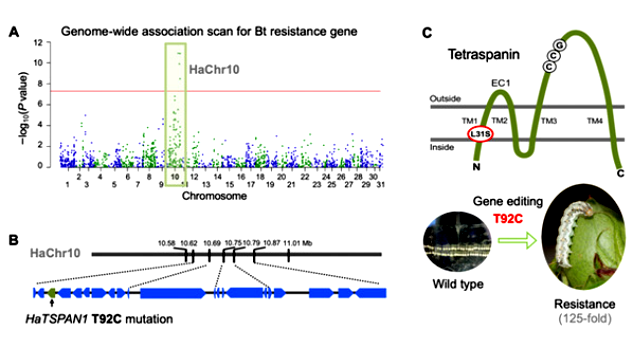Scientists from the group of professor Yidong Wu, College of Plant Protection, Nanjing Agricultural University (NAU) found that an amino acid substitution L31S of HaTSPAN1 of H. armigera was associated with the dominant field-evolved resistance to Bt cotton. The research was published online on November 1, 2018, in the Proceedings of the National Academy of Science (PNAS), associate professor Lin Jin and Ph.D. student Jing Wang are the co-first author, and professor Yidong Wu is the corresponding author.
H. armigera, a major global pest, which is harmful to cotton, corn, soybean and other crops. Planting the transgenic cotton and expressing Cry1Ac are effective strategies to control cotton bollworm. However, with long-time selection pressure of Bt cotton, cotton bollworm could evolve a variety of resistant genes to adapt to Bt cotton, resulting in significant decrease or even complete loss of the efficiency of transgenic Bt cotton. Professor Wu's team carried out systematic research on the occurrence and development rules of resistance to Bt cotton in cotton bollworm in China, and a number of breakthroughs have been achieved. The study of genetic screening revealed the genetic diversity of resistance to Bt in field population of H. armigera in China (PNAS, 2012). Further systematic monitoring and computer simulation conformed that the “natural refuge” can effectively delay the development of recessive resistance, but it could accelerate the evolution of dominant resistance (Nature Biotechnology, 2015). This work identified a novel gene mutation that confers the dominant resistance of H. armigera to Bt cotton. Professor Yidong Wu said, “this is a trilogy of studies on resistance to Bt cotton in cotton bollworm completed by our group during the last decade.”

Point mutation of HaTSPAN1 confers dominant resistance to Bt in H. armigera
The Bt dominant resistance gene was mapped to the specific region of 250 kb length on chromosome 10 of H. armigera by Genome Wide Association Study (GWAS) and fine-scale mapping. We analyzed the amino acid sequences and the expression level of the 21 genes in this region, and a T92C point mutation was found in HaTSPAN1, resulting in amino acid substitution L31S, which was closely linked to the dominant resistance to Bt toxin. Knockout of the resistant gene HaTSPAN1 from resistant strain utilizing CRISPR/Cas9 system resulted in the recovery of susceptibility to Cry1Ac, while knock-in of the T92C point mutation conferred 125-fold resistance to Cry1Ac. The forward and reverse genetic evidences indicated the causal relationship between the point mutation T92C of HaTSPAN1 and the dominant resistance to Bt toxin in H. armigera.
It is generally believed that pests can evolve resistance through loss-of-function mutations of Bt receptor genes (such as cadherin and ABC transporter), which is a recessive inheritance, and only homozygotes show resistance. This study found that the resistance conferred by the function-acquired mutation is dominantly inherited, and the heterozygotes show resistance, so the development of dominant resistance is faster than that of recessive resistance. In this study, we found that the frequency of T92C mutation of HaTSPAN1 gene in the cotton field of northern China is increasing rapidly, and it has increased 100-fold in recent ten years, from 0.1% in 2006 to 10% in 2016.
Transgenic Bt cotton was commercialized in 14 countries to control target pests recently, such as H. armigera. But the evolution of resistance to Bt toxins for pests is the major and common threat to the transgenic technology. To manage Bt resistance, identification of Bt resistance genes and monitoring of its spatiotemporal development are prerequisites.
